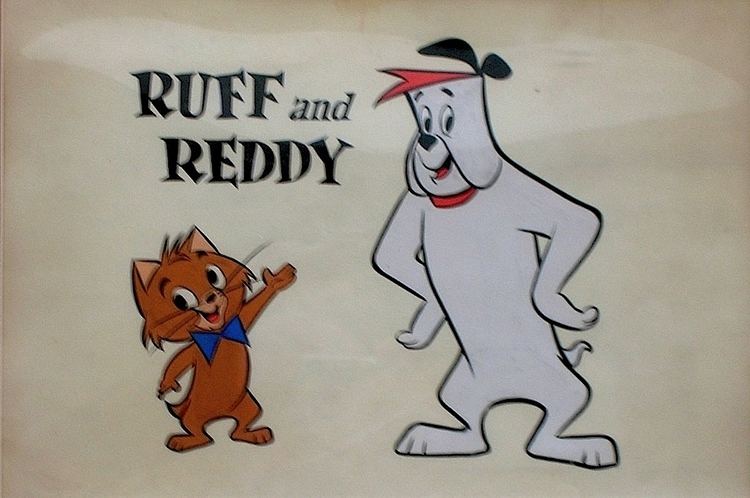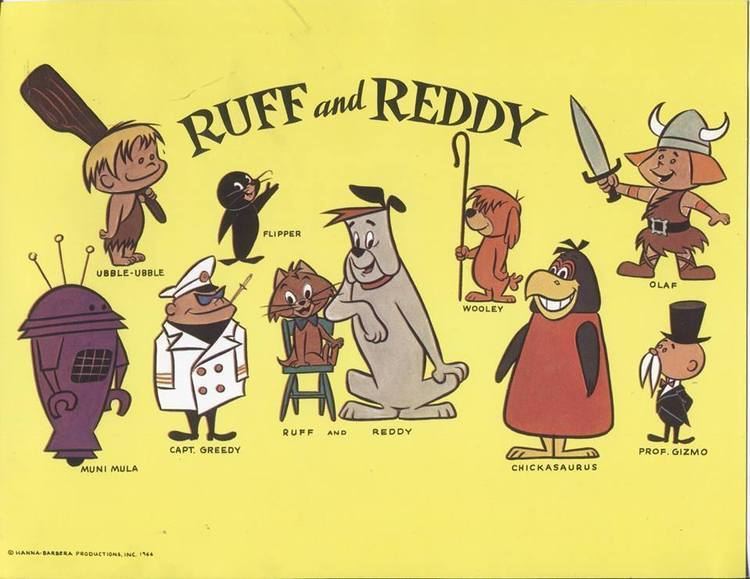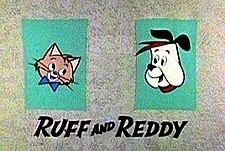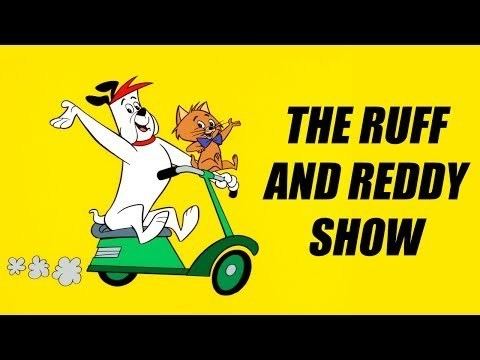7 /10 1 Votes
6.7/10 TV First episode date 14 December 1957 | 7.3/10 IMDb Also known as Ruff and Reddy Final episode date 2 April 1960 Number of seasons 3 | |||||||||||||||||||||||||||||||||
 | ||||||||||||||||||||||||||||||||||
Written by Joseph BarberaCharles Shows Directed by William HannaJoseph BarberaBob Hultgren (NBC sequences) Voices of Daws ButlerDon Messick Cast Daws Butler, Don Messick, Robert Cottle Similar The Quick Draw McGraw, The Huckleberry Hound S, Augie Doggie and Dogg, Peter Potamus, Hokey Wolf | ||||||||||||||||||||||||||||||||||
The Ruff and Reddy Show (also known as Ruff and Reddy) is an American animated television series and the first made by Hanna-Barbera Productions for NBC. The series follows the adventures of Ruff, a smart and steadfast cat, and Reddy, a good-natured and brave (but not overly bright) dog. The series also was presented by Screen Gems, the television arm of Columbia Pictures (now Sony Pictures Television). Ruff and Reddy premiered in December 1957 and ran for fifty episodes until April 1960, comprising three seasons.
Contents
- Background
- Animation
- Writing and music
- Reception
- Voice cast
- Other appearances
- Merchandise
- The Ruff Reddy Show in other languages
- Home Media releases
- References

Hanna and Barbera created the series as the first of their fledgling television operation, first named H-B Enterprises. The "buddy" theme had previously been explored in their Tom and Jerry theatrical shorts, but unlike Tom and Jerry, Ruff and Reddy are not adversaries, but housemates and best friends. The series is notable as one of the earliest original animated television programs, and a pioneering use of limited animation techniques.

Background

In 1957, the animation/director team of William Hanna and Joseph Barbera were terminated from an eighteen-year-long tenure at MGM Studios, producing the animated Tom and Jerry theatrical short subjects. Their staff, composed of 110 inkers, painters, and animators, were also let go. MGM found it more profitable to continually re-release older cartoons than produce new ones. Hanna and Barbera remained a partnership and invested $30,000 out of pocket into a new venture, H-B Enterprises. The duo began work on storyboards featuring new characters, the first among them Ruff, a cat, and Reddy, a dog. Hanna later equated their respective names with he and his partners' dispositions at the period in which they were created. They forged a deal with former MGM colleague George Sidney in which he forged a small percentage of the new company in return for acting as a business representative. Sidney arranged for a meeting at Screen Gems, who had at the time been considering re-entering the animation business. Feeling confidence in the Ruff and Reddy characters, the duo presented their proposal, along with a streamlined production budget employing limited animation.
Animation
Ruff and Reddy, as one of the first original animated series produced for television, pioneered the technique of limited animation. Limited animation would require far fewer drawings, and, by extension, less inking and painting. This method was employed by necessity, as higher budgets had been the cause for the collapse of the theatrical cartoon business. Hanna, in a six-page memo, had attempted to convince his superiors at MGM to employ economized techniques in order to reduce the cost of their short films, but was never responded to. At that time, he had estimated a six-minute cartoon to cost $17,500 if it employed the limited animation technique (down from the $35,000 budget the duo received at MGM). When pitching to Screen Gems, Hanna had worked down the numbers to a much smaller $3,000, and the duo were very confident the company would respond with great excitement. Screen Gems appreciated the show concept, but explained to the duo that the budget for television, still an experimental medium, would be very stringent. Eventually, the company gave the partnership an option to produce five five-minute segments, with an escalating budget starting from $2,700.

Hanna described the process in his 1996 memoir, A Cast of Friends: "It was essential that we select only the key poses necessary to convincingly impart the illusion of movement in our cartoons." This method often emphasizes close-ups, rather than full or medium shots. All in all, the production process for Ruff and Reddy was not dissimilar from the process used to create theatrical cartoons: a script was written, followed by a storyboard illustrating key poses. Afterwards, a recorded soundtrack with dialogue was used to create a "pose reel," which would give the filmmakers a sense of timing. Watching pose reels during their MGM years had emphasized that simple key poses would be enough to demonstrate humor. Hanna believed the process in line with the nature of television during the period, stressing "intimacy rather than spectacle," represented an entirely different viewing experience (a large movie screen versus a small, standard-dimension television screen).
In addition to the quicker, cheaper production process, Hanna and Barbera made the decision to produce the segments in full color. Despite the fact that most television programs of the period were created and broadcast in black and white, "Joe [Barbera] and I could see color programming looming on the television horizon," said Hanna. Ruff and Reddy also eschewed lavish, detailed background art for simple, colorful illustrations.
Writing and music
Hanna and Barbera were fond of the "ongoing comedic rapport" of cartoon duos, among them the Wile E. Coyote/Road Runner and Sylvester/Tweety rivalries of Warner Bros. cartoons. Their own creation at MGM, Tom and Jerry, had been a variation on this theme. With Ruff and Reddy, they decide to delete the nemesis theme and make the characters best friends instead. "Consequently, this softer relationship placed a greater emphasis on the humor and wit conveyed to the audience through dialogue," wrote Hanna.
Hanna wrote the series' theme music, in his first foray into theme music composition, which would become a staple of Hanna-Barbera for nearly 30 years. His goal to capture the spirit of the characters while also catching the listeners' ear, he penned the lyrics one morning while storyboarding, handing off the sheet music to musical director Hoyt Curtin, who composed the melody. Unlike Tom and Jerry, the two new characters would speak, and the duo held auditions to find voice artists. Mainly selecting those they worked with at MGM, Hanna and Barbera decided to cast Don Messick as Ruff and Daws Butler as Reddy.
Reception
The series was set to be the opening and closing acts for a half-hour children's program airing on Saturday afternoons. While they had screened the pilot episode prior to broadcast, Hanna later admitted he was nervous as to how the public would respond. He writes in his book that reviews in trade papers were mainly positive, deeming it an "entertaining and clever cartoon program." NBC, following this success, signed the duo to a five-year contract to produce and develop additional animated television series.
NBC paired the opening and closing episodes of the show (usually with a cliffhanger) with live segments and classic cartoons of The Fox and the Crow and Lil Abner produced by Frank Tashlin for Screen Gems.
Voice cast
Other appearances
Merchandise
The Ruff & Reddy Show in other languages
Home Media releases
Episodes of the series appeared on the Animal Follies volume, part of the Hanna-Barbera Personal Favorites home video series, along with Yippee, Yappee and Yahooey, Touche Turtle and Dum Dum, Augie Doggie and Doggie Daddy and Snagglepuss. The first episode of the show, "Planet Pirates", was listed on the press release for The Best of Warner Bros.: Hanna-Barbera 25 Cartoon Collection DVD set to be released on May 21, 2013. But however due to an inaccuracy on that press announcement, the episode is among several that weren't on the actual set. There has yet to be a complete series DVD of all fifty complete episodes of the show from Warner Archive.
